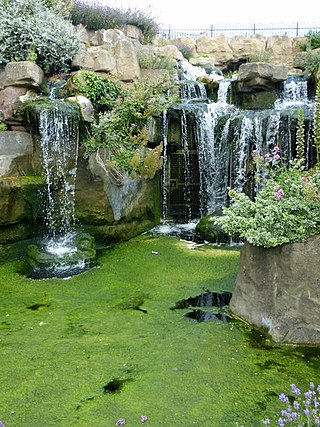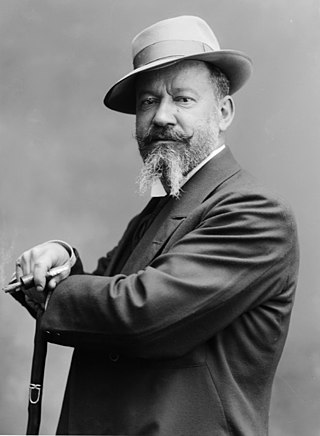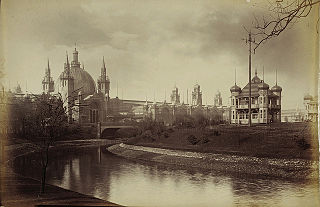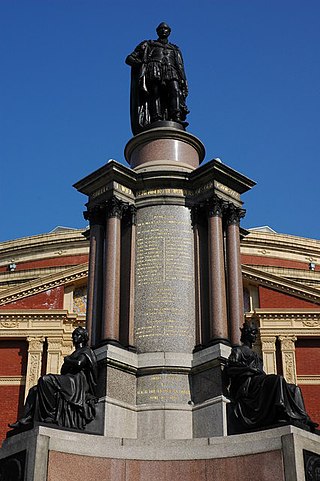


James Pulham and Son was a firm of Victorian landscape gardeners and terracotta manufacturers which exhibited and won medals at London's Great Exhibition of 1851 and 1862 International Exhibition. [2]



James Pulham and Son was a firm of Victorian landscape gardeners and terracotta manufacturers which exhibited and won medals at London's Great Exhibition of 1851 and 1862 International Exhibition. [2]
James Pulham and Son was founded by James Pulham (1765-1830) of Woodbridge in Suffolk, then succeeded by his son James (1793–1838) who was succeeded by his eldest son James (1820–1898) and then by two further generations of eldest sons, all named James. The firm went out of business in 1939. [3]
The firm was best known for the construction of rock gardens, follies and grottoes using both natural stone and their own invention, Pulhamite artificial rock. Pulham and Son also manufactured a wide range of terracotta and Pulhamite garden ornaments, originally at their works in Tottenham, but after 1840 at Broxbourne in Hertfordshire. In 1895 the firm was granted a Royal Warrant by the Prince of Wales, later King Edward VII, and some of their work survives at Sandringham House and Buckingham Palace. [2]
At the Great Exhibition of 1862, the firm exhibited the upper section of the Hebe Fountain, surmounted by a portrayal of the Greek goddess Hebe. James Pullham II (the son) received a recommendation for the architectural decoration in terracotta. The fountain is now at Dunorlan Park, Tunbridge Wells. [4]
At the 1867 Paris Exhibition the company showed the "Preston vase" (several of which were made for the People's Park, Preston), and the Mulready monument. [5] The latter, modelled by Godfrey Sykes [2] consisted of a pedestal 15 feet long and 10 feet wide, supporting an effigy, seven feet long, on a raised bier. It won a silver medal at the exhibition, and was installed at Kensal Green cemetery on its return from Paris. [5]

The International Exhibition of 1862, or the Great London Exposition, was a world's fair held from 1 May to 1 November 1862, beside the gardens of the Royal Horticultural Society, South Kensington, London, England, on a site that now houses museums including the Natural History Museum and the Science Museum.

Sir Joseph Edgar Boehm, 1st Baronet, was an Austrian-born British medallist and sculptor, best known for the "Jubilee head" of Queen Victoria on coinage, and the statue of the Duke of Wellington at Hyde Park Corner. During his career Boehm maintained a large studio in London and produced a significant volume of public works and private commissions. A speciality of Boehm's was the portrait bust; there are many examples of these in the National Portrait Gallery. He was often commissioned by the Royal Family and members of the aristocracy to make sculptures for their parks and gardens. His works were many, and he exhibited 123 of them at the Royal Academy from 1862 to his death in 1890.

Battersea Park is a 200-acre (83-hectare) green space at Battersea in the London Borough of Wandsworth in London. It is situated on the south bank of the River Thames opposite Chelsea and was opened in 1858.

William Calder Marshall ARSA was a Scottish sculptor.

Dunorlan Park is a park and grounds in Royal Tunbridge Wells, UK.

Matthew Cotes Wyatt was a painter and sculptor and a member of the Wyatt family, who were well known in the Victorian era as architects and sculptors.

Sydenham Hill Wood is a ten-hectare wood on the northern slopes of the Norwood Ridge in the London Borough of Southwark. It is designated as a Local Nature Reserve and Site of Metropolitan Importance for Nature Conservation. With the adjacent Dulwich Wood, Sydenham Hill Wood is the largest extant tract of the ancient Great North Wood. The two woods are formed from coppices known as Lapsewood, Old Ambrook Hill Wood and Peckarmans Wood after the relocation of The Crystal Palace in 1854 and the creation of the high level line in 1865.

Pulhamite was a patented anthropic rock material invented by James Pulham (1820–1898) of the firm James Pulham and Son of Broxbourne in Hertfordshire. It was widely used for rock gardens and grottos.

Raffaello Romanelli was an Italian sculptor, born in Florence, Italy.

Alexander Munro was a British sculptor of the Pre-Raphaelite movement. He concentrated on portraiture and statues, but is best known for his Rossetti-influenced figure-group Paolo and Francesca (1852), which has often been identified as the epitome of Pre-Raphaelite sculpture.

Peter Hollins was a British sculptor operating throughout the 19th century.

The International Exhibition of Science, Art and Industry was the first of 4 international exhibitions held in Glasgow, Scotland during the late 19th and early 20th centuries. It took place at Kelvingrove Park between May and November 1888. The main aim of the exhibition was to draw international attention to the city's achievements in applied sciences, industry and the arts during the Industrial Revolution. However, it was also hoped the Exhibition would raise enough money for a much-needed museum, art gallery and school of art in the city. The exhibition was opened by the Prince of Wales, as honorary president of the exhibition, on 8 May 1888. It was the greatest exhibition held outside London and the largest ever in Scotland during the 19th century.

Worth Park is in Pound Hill, Crawley. The park covers eight hectares and includes formal gardens, and a lake area.

Joseph Durham was an English sculptor.
Alfred Gatley was an English sculptor.

Edward Bowring Stephens, was a British sculptor from Devon. He was honorary secretary of the Institute of Sculptors circa 1861.
Frederick Thrupp (1812–1895) was an English sculptor.

John Marriott Blashfield (1811–1882) was a property developer and mosaic floor and ornamental terracotta manufacturer. He originally worked for the cement makers Wyatt, Parker and & Co in Millwall, but moved the business to Stamford in Lincolnshire in 1858, when it was renamed The Stamford Terracotta Company.
James Sherwood Westmacott (1823–1900) was a British sculptor during the 19th century and part of the Westmacott dynasty stemming from Richard Westmacott.
Edward Davis MIBS was a 19th century British sculptor.
![]() Media related to James Pulham and Son at Wikimedia Commons
Media related to James Pulham and Son at Wikimedia Commons